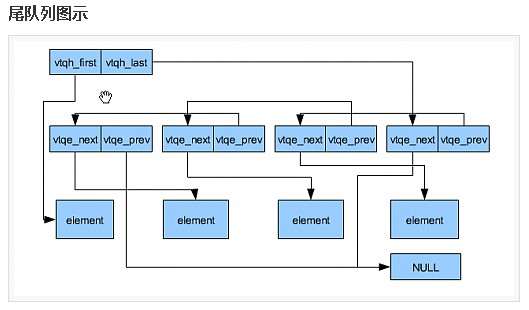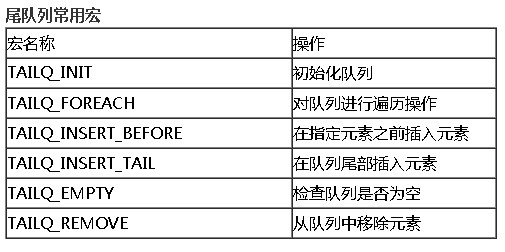c语言尾队列tailq使用示例分享
queue和list的结构定义和操作都在'sys/queue.h'中完成, 主要定义了下面四种数据结构:
1单向列表(single-linked lists)
2单向尾队列(single-linked tail queue)
3列表(lists)
4尾队列(tail queues)

使用示例
#include <stdio.h>
#include <stdlib.h>
#include <sys/queue.h>
/*
定义一个结构体,它只是尾队列的一个元素
它必须包含一个TAILQ_ENTRY来指向上一个和下一个元素
*/
struct tailq_entry {
int value;
TAILQ_ENTRY(tailq_entry) entries;
};
//定义队列的头部
TAILQ_HEAD(, tailq_entry) my_tailq_head;
int main(int argc, char *argv[])
{
//定义一个结构体指针
struct tailq_entry *item;
//定义另外一个指针
struct tailq_entry *tmp_item;
//初始化队列
TAILQ_INIT(&my_tailq_head);
int i;
//在队列里添加10个元素
for(i=0; i<10; i++) {
//申请内存空间
item = malloc(sizeof(*item));
if (item == NULL) {
perror("malloc failed");
exit(-1);
}
//设置值
item->value = i;
/*
将元素加到队列尾部
参数1:指向队列头的指针
参数2:要添加的元素
参数3:结构体的变量名
*/
TAILQ_INSERT_TAIL(&my_tailq_head, item, entries);
}
//遍历队列
printf("Forward traversal: ");
TAILQ_FOREACH(item, &my_tailq_head, entries) {
printf("%d ",item->value);
}
printf("\n");
//添加一个新的元素
printf("Adding new item after 5: ");
TAILQ_FOREACH(item, &my_tailq_head, entries) {
if (item->value == 5) {
struct tailq_entry *new_item = malloc(sizeof(*new_item));
if (new_item == NULL) {
perror("malloc failed");
exit(EXIT_FAILURE);
}
new_item->value = 10;
//插入一个元素
TAILQ_INSERT_AFTER(&my_tailq_head, item, new_item, entries);
break;
}
}
TAILQ_FOREACH(item, &my_tailq_head, entries) {
printf("%d ", item->value);
}
printf("\n");
//删除一个元素
printf("Deleting item with value 3: ");
for(item = TAILQ_FIRST(&my_tailq_head); item != NULL; item = tmp_item) {
if (item->value == 3) {
//删除一个元素
TAILQ_REMOVE(&my_tailq_head, item, entries);
//释放不需要的内存单元
free(item);
break;
}
tmp_item = TAILQ_NEXT(item, entries);
}
TAILQ_FOREACH(item, &my_tailq_head, entries) {
printf("%d ", item->value);
}
printf("\n");
//清空队列
while (item = TAILQ_FIRST(&my_tailq_head)) {
TAILQ_REMOVE(&my_tailq_head, item, entries);
free(item);
}
//查看是否为空
if (!TAILQ_EMPTY(&my_tailq_head)) {
printf("tail queue is NOT empty!\n");
}
return 0;
}
相关文章
- 这篇文章主要介绍了c++中system("pause")的作用和含义,非常不错,具有参考借鉴价值,需要的朋友参考下吧...2020-04-25
基于BootStrap Metronic开发框架经验小结【八】框架功能总体界面介绍
这篇文章主要介绍了基于BootStrap Metronic开发框架经验小结【八】框架功能总体界面介绍 的相关资料,需要的朋友可以参考下...2016-05-14- 这篇文章主要介绍了C# 16 进制字符串转 int的方法,非常不错,具有参考借鉴价值,需要的朋友可以参考下...2020-06-25
- 队列的特性很简答,就是先进先出,一般利用数组来实现,本文就介绍了C#队列的简单使用,文中根据实例编码详细介绍的十分详尽,具有一定的参考价值,感兴趣的小伙伴们可以参考一下...2022-03-17
- 这篇文章主要介绍了SpringBoot集成Redis实现消息队列的方法,文中通过示例代码介绍的非常详细,对大家的学习或者工作具有一定的参考学习价值,需要的朋友们下面随着小编来一起学习学习吧...2021-02-10
InterlliJ IDEA2020新建java web项目找不到Static Web的解决
这篇文章主要介绍了InterlliJ IDEA2020新建java web项目找不到Static Web的解决,文中通过示例代码介绍的非常详细,对大家的学习或者工作具有一定的参考学习价值,需要的朋友们下面随着小编来一起学习学习吧...2020-09-02- 这篇文章主要介绍了C#类中static变量用法,实例分析了static变量使用技巧与相关注意事项,需要的朋友可以参考下...2020-06-25
- 这篇文章主要介绍了C#判断一个字符串是否是数字或者含有某个数字的方法,本文给大家介绍的非常详细,具有一定的参考借鉴价值,需要的朋友可以参考下...2020-06-25
- 这篇文章主要给大家介绍C# winform快捷键设置技巧,涉及到C winform快捷键相关知识,对C winform知识感兴趣的朋友可以参考下本篇文章...2020-06-25
- 这篇文章主要介绍了基于Ionic3实现选项卡切换并重新加载echarts,文中通过示例代码介绍的非常详细,对大家的学习或者工作具有一定的参考学习价值,需要的朋友可以参考下...2020-09-24
- 最近项目不多忙,于是抽点时间巩固下切换窗口问题,感兴趣的朋友跟着小编一起学习吧...2020-06-25
pytorch绘制并显示loss曲线和acc曲线,LeNet5识别图像准确率
今天小编就为大家分享一篇pytorch绘制并显示loss曲线和acc曲线,LeNet5识别图像准确率,具有很好的参考价值,希望对大家有所帮助。一起跟随小编过来看看吧...2020-05-02- 这篇文章主要为大家详细介绍了PC蓝牙通信C#代码实现,具有一定的参考价值,感兴趣的小伙伴们可以参考一下...2020-06-25
基于BootStrap Metronic开发框架经验小结【六】对话框及提示框的处理和优化
这篇文章主要介绍了基于BootStrap Metronic开发框架经验小结【六】对话框及提示框的处理和优化的相关知识,主要对比说明在Bootstrap开发中用到的这些技术要点,对此文感兴趣的朋友一起学习吧...2016-05-14- 这篇文章主要介绍了C#实现带进度条的ListView 的相关资料,需要的朋友可以参考下...2020-06-25
- 这篇文章主要介绍了SpringMVC文件上传原理及实现过程解析,文中通过示例代码介绍的非常详细,对大家的学习或者工作具有一定的参考学习价值,需要的朋友可以参考下...2020-07-15
- 这篇文章主要介绍了C#向线程中传递多个参数的解决方法(两种)的相关资料,非常不错,具有参考借鉴价值,需要的朋友可以参考下...2020-06-25
- 这篇文章主要介绍了c++优先队列(priority_queue)用法详解,文中通过示例代码介绍的非常详细,对大家的学习或者工作具有一定的参考学习价值,需要的朋友们下面随着小编来一起学习学习吧...2020-04-25
C# MVC模式中应该怎样区分应用程序逻辑(Controller层)和业务逻辑(Model层)?
这篇文章主要介绍了C# MVC模式中应该怎样区分应用程序逻辑(Controller层)和业务逻辑(Model层)?,这也小编做.NET项目时经常思考和让人混乱的一个问题,这篇文章写的挺好,一下清晰了许多,需要的朋友可以参考下...2020-06-25ShardingSphere jdbc集成多数据源的实现步骤
本文主要介绍了ShardingSphere jdbc集成多数据源的实现步骤,文中通过示例代码介绍的非常详细,具有一定的参考价值,感兴趣的小伙伴们可以参考一下...2021-10-21
